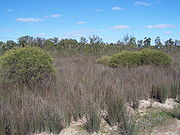
Brixton Street Wetlands
Encyclopedia


Wetland
A wetland is an area of land whose soil is saturated with water either permanently or seasonally. Wetlands are categorised by their characteristic vegetation, which is adapted to these unique soil conditions....
area in the city of Perth
Perth, Western Australia
Perth is the capital and largest city of the Australian state of Western Australia and the fourth most populous city in Australia. The Perth metropolitan area has an estimated population of almost 1,700,000....
, Western Australia
Western Australia
Western Australia is a state of Australia, occupying the entire western third of the Australian continent. It is bounded by the Indian Ocean to the north and west, the Great Australian Bight and Indian Ocean to the south, the Northern Territory to the north-east and South Australia to the south-east...
. The wetlands are located in the suburb of Kenwick
Kenwick, Western Australia
Kenwick, Western Australia is a mixed residential, light industrial and semi-rural suburb located in the south-east of Perth, Western Australia, located within the City of Gosnells...
, in the south-east of the city not far from the foot of the Darling Scarp
Darling Scarp
The Darling Scarp, also referred to as the Darling Range or Darling Ranges, is a low escarpment running north-south to the east of the Swan Coastal Plain and Perth, Western Australia...
. The Brixton Street Wetlands occupies 1.26 km² adjoining urban residential developments, schools and remnant semi-rural properties in an area which is rapidly urbanising. The Roe Highway
Roe Highway
Roe Highway is a limited access dual carriageway in Western Australia. It links Great Northern Highway and Middle Swan Road with Kwinana Freeway. It is one of the key heavy vehicle routes in the Perth metropolitan area. Aside from intersections, the speed limit is 100 km/h for most of its length...
, a major transport artery, runs along one boundary of the wetlands, together with a parallel railway line.
The wetlands contain a huge number of plant species for such a small area, some of which are rare and endangered. Over 400 plant species, comprising some 20% of the flora species of the Perth area, can be found in the wetlands. Of these, about 80 flowering plants are considered endangered and are not commonly found on the Swan Coastal Plain
Swan Coastal Plain
The Swan Coastal Plain in Western Australia is the geographic feature which contains the Swan River as it travels west to the Indian Ocean. The coastal plain continues well beyond the boundaries of the Swan River and its tributaries, as a geological and biological zone, one of Western Australia's...
on which Perth is located, and the plant communities located here are in fact the last substantial wetland plant communities on the plain's claypans. Four of the species are classified as Declared Rare Flora, including the Purdie's donkey orchid
Orchidaceae
The Orchidaceae, commonly referred to as the orchid family, is a morphologically diverse and widespread family of monocots in the order Asparagales. Along with the Asteraceae, it is one of the two largest families of flowering plants, with between 21,950 and 26,049 currently accepted species,...
(Diuris Purdiei
Diuris
Diuris is a genus of herbaceous plant belonging to the orchid family , with more than fifty described species. The genus is presently being revised, with many newly described species....
).
Fauna include frogs, snakes and insects, but the wetlands are especially important as a habitat for the rare southern brown bandicoot (Isoodon Obesulus), often known by its Nyoongar Aboriginal name of Quenda.
The wetlands were entered A Directory of Important Wetlands in Australia
A Directory of Important Wetlands in Australia
A Directory of Important Wetlands in Australia is a list of wetlands of national importance to Australia. Intended to augment the list of wetlands of international importance under the Ramsar Convention, it was formerly published in report form, but is now essentially an online publication...
in 1992 (recorded there as the Brixton Street Swamps), and were placed on the Register of the National Estate
Register of the National Estate
The Register of the National Estate is a listing of natural and cultural heritage places in Australia. The listing was initially compiled between 1976 and 2003 by the Australian Heritage Commission. The register is now maintained by the Australian Heritage Council...
of the Australian Heritage Commission on November 21, 2000.

